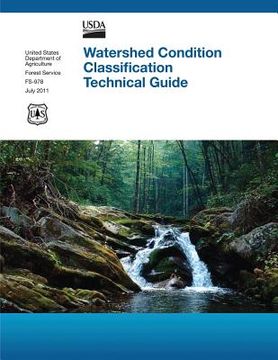Share
Watershed Condition Classification Technical Guide (in English)
U. S. Department of Agri Forest Service
(Author)
·
John P. Potyondy
(Author)
·
Theodore W. Geier
(Author)
·
Createspace Independent Publishing Platform
· Paperback
Watershed Condition Classification Technical Guide (in English) - Potyondy, John P. ; Geier, Theodore W. ; Forest Service, U. S. Department of Agri
$ 13.59
$ 16.99
You save: $ 3.40
Choose the list to add your product or create one New List
✓ Product added successfully to the Wishlist.
Go to My WishlistsIt will be shipped from our warehouse between
Monday, July 08 and
Tuesday, July 09.
You will receive it anywhere in United States between 1 and 3 business days after shipment.
Synopsis "Watershed Condition Classification Technical Guide (in English)"
The U.S. Department of Agriculture (USDA) Strategic Plan for fiscal year (FY) 2010-2015 targets the restoration of watershed and forest health as a core management objective of the national forests and grasslands. To achieve this goal, the Forest Service, an agency of USDA, is directed to restore degraded watersheds by strategically focusing investments in watershed improvement projects and conservation practices at landscape and watershed scales. The Forest Service formed the National Watershed Condition Team and tasked it with developing a nationally consistent, science-based approach to classify the condition of all National Forest System (NFS) watersheds and to develop outcome-based performance measures for watershed restoration. The team evaluated alternative approaches for classifying watersheds (USDA Forest Service 2007) and developed the watershed condition classification (WCC) system described in this technical guide. The team designed the WCC system to-Classify the condition of all NFS watersheds; Be quantitative to the extent feasible; Rely on Geographic Information System (GIS) technology; Be cost effective; Be implementable within existing budgets; Include resource areas and activities that have a significant influence on watershed condition. National forests are required to revise the classification on an annual basis. The WCC system is a national forest-based, reconnaissance level evaluation of watershed condition achievable within existing budgets and staffing levels that can be aggregated for a national assessment of watershed condition. The WCC system offers a systematic, flexible means of classifying watersheds based on a core set of national watershed condition indicators. The system relies on professional judgment exercised by forest interdisciplinary (ID) teams, GIS data, and national databases to the extent they are available, and on written rule sets and criteria for indicators that describe the three watershed condition classes (functioning properly, functioning at risk, and impaired function). The WCC system relies on Washington Office and regional office oversight for flexible and consistent application among national forests. The WCC system is a first approximation of watershed condition, and we will revise and refine it over time. The expectation is that we will improve and refine individual resource indicators and that we will develop databases and map products to assist with future classifications. The WCC information will be incorporated into the watershed condition framework, which will ultimately be employed to establish priorities, evaluate program performance, and communicate watershed restoration successes to interested stakeholders and Congress. The watershed condition goal of the Forest Service is "to protect National Forest System watersheds by implementing practices designed to maintain or improve watershed condition, which is the foundation for sustaining ecosystems and the production of renewable natural resources, values, and benefits" (FSM 2520). U.S. Secretary of Agriculture Tom Vilsack reemphasized this policy in his "Vision for the Forest Service" when he stated that achieving restoration of watershed and forest health would be the primary management objective of the Forest Service (USDA 2010). This Watershed Condition Classification Technical Guide helps to implement this policy objective by-1. Establishing a systematic process for determining watershed condition class that all national forests can apply consistently; 2. Improving Forest Service reporting and tracking of watershed condition; 3. Strengthening the effectiveness of the Forest Service to maintain and restore the productivity and resilience of watersheds and their associated aquatic systems on NFS lands.

